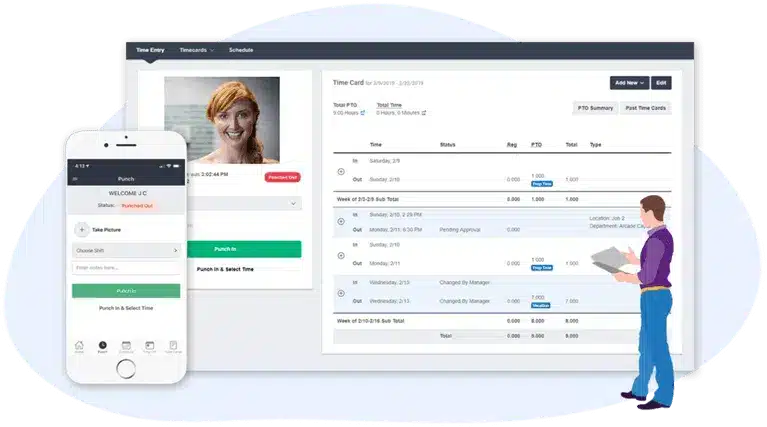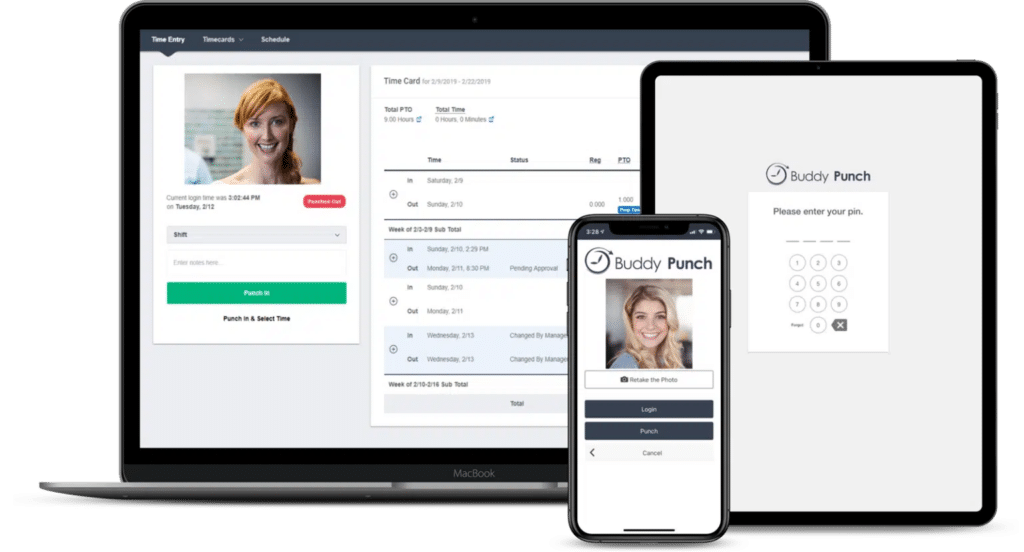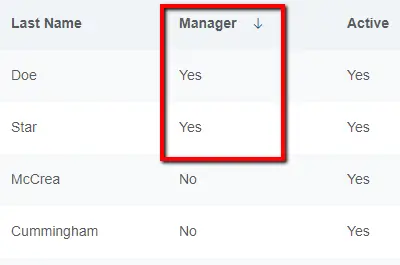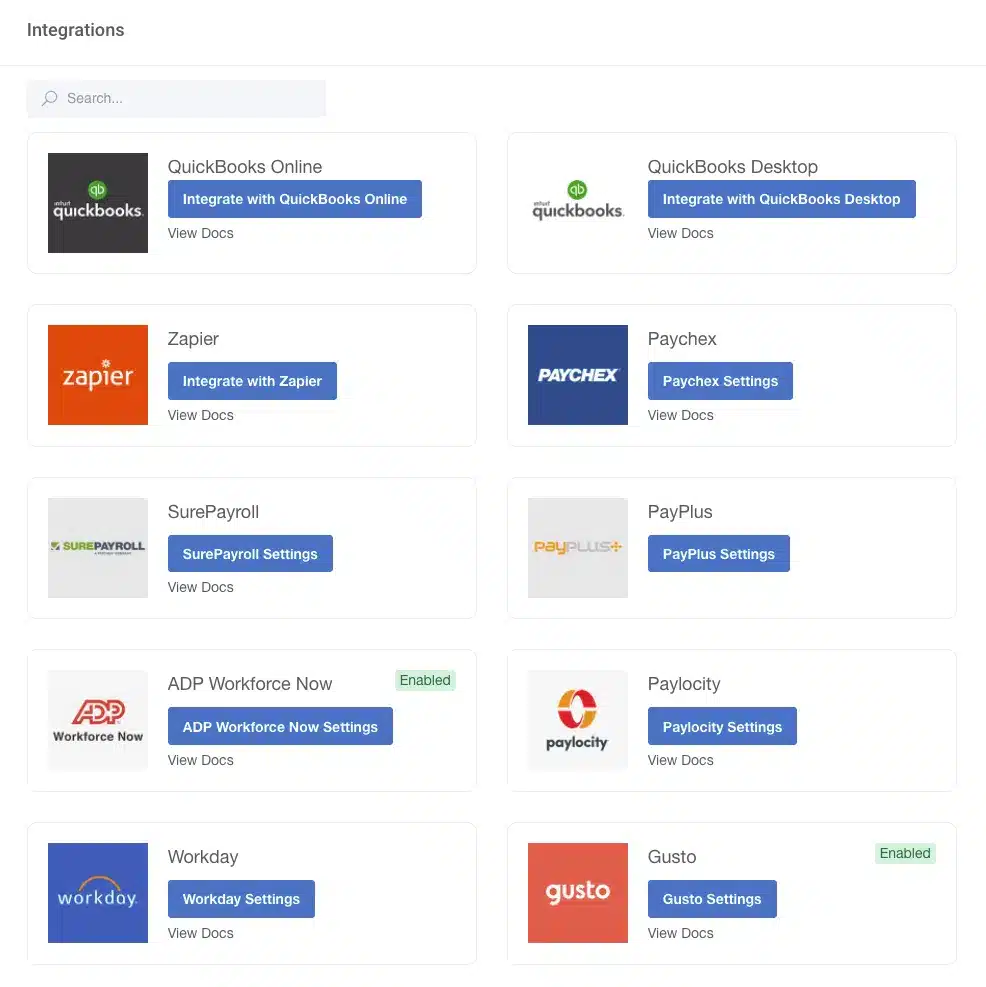What is Paid Time Off? What Is Meant By PTO?

Paid Time Off (often abbreviated to PTO) refers to the time an employer grants an employee for that team member to spend outside the office while still receiving compensation.
While certain aspects of PTO are state- or industry-mandated, there is plenty of wiggle room for business owners to adjust based on what’s right for their workplace.
Therein lies the power of understanding everything that goes into a paid time off policy.
It’s key to ensure that your business operations run smoothly year-round and for team members to establish a work-life balance that enables them to be as productive as possible.
Otherwise, you’re looking at higher turnover rates and difficulties recruiting top-tier talent.
As part of Buddy Punch’s ongoing efforts to equip managers and business owners with all the tools they need to run a business smoothly, we’ve created this one-stop guide to all things related to answering the question, “what is paid time off?”
Table of Contents
- How PTO Works?
- What’s The Main Purpose Of Having PTO?
- The Most Common Types of Paid Time Off (PTO)
- What is a PTO Tracking System?
- Reasons to Use a PTO Tracking System
- What to Look For in a PTO Tracking System
- Buddy Punch | Best PTO Tracking System
- Is Paid Time Off Actually Paid?
- How Do You Accrue PTO and Vacation Time?
- Understanding the Benefits of A Leave Policy
- The Pros and Cons of Different Leave Policies
- Advantages of PTO Planning and Policies
- Paid Time Off: Data & Statistics
- Questions to Ask Yourself Before Forming a PTO Policy
- PTO Tips and Techniques
- Maximize Employee Engagement with Time Tracking Software
- What are PTO Blackout Periods, and are they Legal?
- Is Personal Time Off The Same As Paid Time Off?
- Try Buddy Punch for Free
- FAQs
What is a Paid Time Off Policy, and How Does it Work?
Paid Time Off is when an employer grants an employee leave.
A Paid Time Off Policy is a contractual agreement between manager and employee that details the number of days a part-time or full-time employee will be granted and in what instances.
Employees typically agree to PTO policies as outlined in the employment contract or handbook.
This results in personal leave, vacation time, and sick leave being established between you and your employees, leaving it up to them to decide how they spend their days going forward.
That said – it’s important to note that the Fair Labor Standards Act (FLSA) does not require payment for vacation days.
The matter is entirely between you as an employer and your employees.
So why do so many companies bother providing PTO at all?
A high–quality Paid Time Off Policy is how you stay competitive when attracting talent.
From sick time to marriage, bereavement leave, vacation time, or even a purely personal leave of absence, the ability for an employee to take time away from their job is, ironically, a critical component to keeping high-quality members around and happy.
PTO Terminologies Commonly Used

| Terminology | Definition |
| PTO (Paid Time Off) | General term encompassing various types of paid leave, including vacation days, personal days, and sometimes sick leave. |
| Vacation Days | Specific days an employee takes off for leisure, relaxation, or personal activities while receiving pay. |
| Sick Leave | Paid time off granted to employees who are unwell or need to attend to medical appointments. |
| Personal Days | Days off that employees can use for personal reasons, distinct from vacation or sick leave. |
| Floating Holidays | Additional paid days off that employees can take at their discretion, often for cultural or religious observances. |
| Accrual | The process of accumulating PTO based on an employee’s time worked, typically calculated on a per-pay-period basis. |
| PTO Bank | The total amount of paid time off that an employee has accrued and can utilize. |
| PTO Balance | The remaining amount of PTO an employee has available after accounting for used days. |
| Use-It-or-Lose-It Policy | A policy that requires employees to use their accrued PTO within a specified timeframe, usually by the end of the year, or forfeit unused days. |
| Roll Over | Allowing employees to carry over unused PTO from one year to the next, preserving accrued time. |
| Blackout Period | A specified timeframe during which employees are restricted from taking PTO, often due to busy seasons or critical business operations. |
| Compensatory Time (Comp Time) | Time off provided as compensation for overtime work instead of monetary payment. |
| Maternity/Paternity Leave | Time off granted to new parents for the birth or adoption of a child. |
| Request for Time Off (RTO) | The formal process through which employees submit a request to take PTO, usually through a company’s HR or time-tracking system. |
| PTO Policy | The set of rules and guidelines established by an employer regarding the accrual, usage, and other aspects of paid time off. |
| Holiday Pay | Compensation provided to employees for designated public or company holidays. |
| Flex Time | A flexible work arrangement allowing employees to adjust their work hours within certain limits. |
| PTO Buyback | A policy allowing employees to sell back unused PTO for monetary compensation. |
| Wellness Days | Days off intended for employees to focus on their well-being and mental health. |
| Catastrophic Leave | A program allowing employees to donate accrued PTO to colleagues facing prolonged illness or personal emergencies. |
How PTO Works?
While employers have complete freedom regarding handling paid leave days, the three most common types of PTO tend to be Accrual, Lump Sum, and Unlimited.
Lump Sum PTO
With Lump Sum PTO Policies (Annual Allotment), employees are given a set number of vacation days per year.
This is usually received on a certain date, such as January 1st (the start of a calendar year), the beginning of a fiscal year, or the 1st anniversary of their joining the company.
Days from the previous year will either expire with the arrival of a new lump sum or rollover and continue building up.
Lump Sum PTO banks are easier for payroll departments to manage since they are set around set dates.
Accrual PTO
With accrued PTO, rather than receiving a lump sum of days to be used or rolled over, employees build up PTO days over time, usually weekly, monthly, or quarterly.
It’s important to note that with accrued paid time off, unused vacation days usually have no rollover policy.
Instead, you can expect a limit on the maximum number of days that can be spent at once. Employee leaves are also staggered to prevent understaffing.
Even with an established accrual rate, calculating the amount of time off each employee has can be challenging for HR and Payroll departments.
Unlimited PTO
The third most common method is implementing a completely unlimited PTO policy.
This is the most trust-focused method of handling PTO and operates with the understanding that your employees will not abuse the system and will remain productive.
That said, advanced notices will be key to prevent HR departments from suddenly finding themselves missing key staff members at critical moments.
Try Buddy Punch For Free
What’s The Main Purpose Of Having PTO?
The main purpose of Paid Time Off (PTO) is to provide employees with designated periods of paid leave from work, promoting a healthy work-life balance and supporting overall well-being.
PTO serves several key purposes.
Employee Well-Being
PTO is designed to give employees time away from work to rest, recharge, and attend to personal matters. This contributes to their physical and mental well-being, reducing stress and preventing employee burnout.
Work-Life Balance
PTO allows employees to balance their professional and personal lives.
It acknowledges that individuals have responsibilities and interests outside of work and will enable them to address those aspects without sacrificing income.
Vacation and Recreation
PTO is commonly used for vacations and recreational activities, enabling employees to take planned breaks for leisure, travel, and quality time with family and friends.
Health and Medical Needs
PTO encompasses sick leave, allowing employees to take time off when they are unwell or need to attend medical appointments without financial repercussions.
Family and Personal Obligations
Employees may use PTO to fulfill family obligations, such as attending events, caring for family members, or dealing with personal matters.
Reducing Absenteeism
By offering paid time off, employers can reduce unplanned absenteeism.
When employees have access to PTO, they are more likely to communicate and plan their time off in advance, minimizing disruptions to workflow.
Boosting Employee Morale and Productivity
Knowing they have the opportunity for paid time off enhances employee morale and job satisfaction.

A well-rested and satisfied workforce tends to be more productive and engaged.
Retention and Recruitment
Competitive PTO benefits can be a key factor in attracting and retaining top talent.
Employees often consider the overall compensation package, including PTO, when evaluating job opportunities.
Legal Compliance
Offering PTO helps employers comply with labor laws and regulations.
It ensures that employees receive compensation for time away from work, aligning with fair labor standards and promoting ethical employment practices.
The Most Common Types of Paid Time Off (PTO)
Below, we’ll do a quick rundown of the most common reasons that you’ll find employees needing to take days off work.
1. Vacation Days | What is Vacation Time?
Simple enough, you’ll want to give employees time to travel, relax with friends and family, and take a break from work.

Note: If you’re wondering, “What is paid time off vs. vacation time off?”
Paid Time Off includes the following instances on this list, plus more.
Meanwhile, vacation time is just one type of paid time off. A bagel is a grain, but not all are bagels.
All vacations are PTO, but not all PTO is vacation time.
2. Sick Leave
This has become increasingly relevant since the COVID-19 pandemic.
Still, you don’t want employees spreading sickness at the workplace, especially considering an ill employee will be much less productive.
Let your employees take time away from the workplace to recover, especially since that’ll make them better quicker.
3. Personal Time
No questions asked, taken at the employee’s discretion.
It is usually used for moving, family emergencies, or stress.
4. Holidays
Holiday pay goes to days like Thanksgiving Day, Christmas Day, Martin Luther King Jr. Day, and any other days you choose (the federal holiday calendar makes an excellent guide).
5. Bereavement
Paid bereavement leave is time an employee can spend to cope with the loss of a family member or friend.
Some businesses vary the time depending on a team member’s relationship with the deceased and may ask for proof such as an obituary or a funeral program.
Be aware that such measures might be viewed unfavorably.
6. Parental Leave
Paid Parental Leave is time away from work to be used on maternal leave, paternity leave, or adoption.
Be aware of federal laws here – for example, the Family Medical Leave Act (FMLA) requires eligible employees to be granted 12 weeks of unpaid, job-protected leave each year, though there are restrictions.
7. Jury Duty
This allows your employees to complete compulsory jury duty service.
If your state has jury duty pay laws, you must obey them.
You can require the jury duty summons later as proof before offering compensation.
8. Voting Time
Paid voting time is the time employees can use to vote in local or national elections.
This is normally limited.
9. Military Leave
Military Leave under USERRA provides job protections thanks to federal law.
This allows employees to fulfill any military obligations.
10. Community Service
This paid time off allows your team members to participate in community-building programs or help in non-profit volunteer efforts.
Ready to give Buddy Punch a try?
For free trial, no credit card required.
What is a PTO Tracking System?
A PTO (Paid Time Off) tracking system is a digital tool or software designed to streamline and automate employee leave management, ensuring accurate and efficient tracking of accrued, used, and available paid time off.
This system replaces manual or paper-based methods, offering a centralized platform for employees and employers to manage time-off requests and balances.
Key features of a PTO tracking system include:
- The ability to submit and approve time-off requests.
- Real-time visibility into remaining PTO balances.
- Automated accrual calculations based on company policies.
The system helps organizations maintain compliance with labor laws, prevent errors in leave calculations, and enhance overall workforce management.
Furthermore, PTO tracking systems often integrate with payroll and HR systems, simplifying administrative processes and reducing the likelihood of errors.
By providing a transparent and accessible platform, these systems contribute to a more organized and employee-friendly approach to time-off management, fostering better communication and accountability within the workplace.
Reasons to Use a PTO Tracking System
Implementing a PTO tracking system offers numerous advantages for both employers and employees.
Firstly, it streamlines and automates managing paid time off, reducing administrative burden.
This results in increased accuracy in tracking accruals, usage, and balances.
Furthermore, a PTO tracking system enhances transparency and communication.
Employees can easily view their accrued PTO, request time off, and receive prompt approvals or denials.
This fosters a more efficient and collaborative work environment.
Employers, in turn, gain a centralized platform to monitor staffing levels, plan for peak work periods, and ensure business continuity.
Moreover, the system aids in compliance with labor laws and company policies, preventing unintentional violations.
Accurate record-keeping also mitigates disputes and ensures fair treatment regarding PTO accruals and usage.
In addition, it facilitates strategic workforce planning by providing valuable insights into employee availability, helping businesses optimize staffing levels and maintain productivity.
What to Look For in a PTO Tracking System
When selecting a PTO tracking system for your organization, it’s essential to consider various features and functionalities to ensure it meets your specific needs.
Here’s what to look for in a PTO tracking system:
User-Friendly Interface
The system should have an intuitive and user-friendly interface, making it easy for employees and administrators to navigate and use the platform efficiently.
Accrual Management
A robust PTO tracking system should support flexible accrual policies, allowing you to set up rates based on employee tenure, hours worked, or other relevant factors.
Customization Options
Look for a system that allows you to customize PTO policies to align with your organization’s specific rules and regulations, including rollover limits, blackout periods, and any other unique requirements.
Integration with Payroll Systems
Seamless integration with payroll systems ensures accurate and efficient processing of
PTO-related payroll transactions, reducing manual data entry errors and saving time.
Employee Self-Service
An effective PTO tracking system should include a self-service portal for employees to view their PTO balances, submit time-off requests, and track the status of their demands in real-time.
Notifications and Reminders
Look for a system to send automated notifications and reminders to employees and managers about upcoming PTO requests, expiring balances, or other relevant events.
Comprehensive Reporting
Robust reporting capabilities are crucial for tracking PTO usage, analyzing trends, and generating reports for compliance purposes or management insights.
Mobile Accessibility
A PTO tracking system with mobile accessibility (for both mobile devices with mobile apps on Android and iOS) allows employees to access the platform and submit time-off requests conveniently, especially if they are away from their desks.
Buddy Punch | Best PTO Tracking System

Buddy Punch is not just another employee time tracking system but a comprehensive workforce management solution that excels in PTO tracking.
Whether you run a small business or a large enterprise, Buddy Punch is designed to meet your specific needs, offering a range of features that simplify managing employee time off.
User-Friendly Interface
Buddy Punch boasts an intuitive and user-friendly interface, making navigating easy for employees and administrators.

The clean design ensures a smooth experience, eliminating the learning curve typically associated with new software.
Flexible PTO Policies
One size does not fit all when it comes to PTO policies.
Buddy Punch allows you to customize PTO policies based on your company’s unique requirements.
Whether you have accrued time off, floating holidays, or both, the system adapts to your specific policies.
Accurate Time Tracking
Accuracy is paramount in any PTO tracking system.
You can bid farewell to manual errors and time discrepancies with Buddy Punch.
The system’s precise time tracking ensures that your employees’ PTO balances are always current, promoting transparency and trust.
Real-Time Monitoring
Stay in the loop with real-time monitoring of employee PTO requests.
Administrators can easily view and approve/reject bids promptly, keeping the workflow smooth and minimizing disruptions.

Compliance and Reporting
Compliance with labor laws and regulations is non-negotiable.
Buddy Punch comes equipped with robust reporting features that facilitate compliance monitoring.

Generate reports effortlessly to ensure that your PTO policies align with legal requirements.
Integration Capabilities
Buddy Punch understands the importance of integration with other business tools.

Whether it’s payroll software, HR systems, or project management tools, Buddy Punch seamlessly integrates to enhance overall efficiency.
Mobile Accessibility
In remote work and on-the-go operations, mobile accessibility is crucial.

Buddy Punch offers mobile apps (Android and iOS) that allows employees to request PTO and supervisors to manage approvals conveniently from their smartphones.
Benefits of Using Buddy Punch for PTO Tracking
- Time Savings: Automate your PTO tracking process and save valuable time for both employees and administrators.
- Reduced Errors: Eliminate the risk of errors associated with manual PTO tracking, ensuring accurate records.
- Enhanced Transparency: Promote transparency in your organization’s PTO balances, approvals, and overall time tracking.
- Improved Employee Satisfaction: A streamlined PTO tracking system enhances employee satisfaction by providing a hassle-free experience.
Buddy Punch’s Online Reviews

“Delighted! As a trucking company and having resources starting their shifts at different times and in different locations it was “effort” in tying this all together to ensure everyone was being paid for correct times – doing payroll was a chore in calling and requesting and then finally imposing deadlines or you don’t get paid which pushes other things back in processing payroll… Week one of deployment -> all those issues disappeared!!! Well done Buddy Punch!!!!”
Click here to read the full review.
“Buddy Punch has been my main source for time tracking since I started my new position. It is user friendly!”
Click here to read the full review.
“The ease of clocking in and out, where ever I may need to punch in. I like that employees are able to make an adjustment to their time and then it gets approved by manager. Which is much easier than having to make punches and delete punches.”
Click here to read the full review.
Try Buddy Punch for Free
Ready to start a free trial?
No credit card required, all features included.
If you feel that Buddy Punch might fit your business, sign up for a 14-day free trial (no credit card needed). You can also book a one-on-one demo or view a pre-recorded demo video.
Is Paid Time Off Actually Paid?
This will depend on a state-by-state basis.
Some states require that accrued PTO be paid, while others let companies issue their policies.
Before creating a PTO policy, you must look into your state’s paid time off laws.
California, for example, not only requires that all PTO be paid out but that it must be paid out at the employee’s current pay rate.
Many states consider PTO a part of an employee’s “final wages,” to be received upon termination of employment.

How Do You Accrue PTO and Vacation Time?
The accrual of Paid Time Off (PTO) and vacation time can vary based on an employer’s policy and the frequency of payroll cycles.
Different companies may adopt distinct accrual methods to manage employee time-off benefits.
Here’s a breakdown of how PTO and vacation time are commonly accrued.
| Frequency | Accrual Basis | Calculation Method |
| Hourly | Based on the number of hours worked | Accumulate a certain amount of PTO for each hour worked |
| Daily | Calculated daily | Earn a specified amount of PTO for each day worked |
| Biweekly | Based on a two-week pay period | Accrue a set amount of PTO for each biweekly pay period |
| Semimonthly | Calculated over two specific periods within a month | Accumulate PTO based on hours worked during semi-monthly periods |
| Monthly | Determined every month | Earn a certain amount of PTO for each month worked |
| Yearly | Based on the total number of hours or days worked throughout the year | Accumulate PTO on an annual basis |
The chosen accrual method depends on the company’s policies and the preferences of both employers and employees.
Employees must familiarize themselves with their company’s specific PTO accrual system to understand how and when they accumulate paid time off.
Additionally, employers should communicate the accrual method and any associated rules or limitations to ensure transparency and fairness in managing employee benefits.
The Difference Between Vacation and Paid Time Off
| Aspect | Vacation | Paid Time Off (PTO) |
| Definition | Time off specifically designated for leisure, rest, or personal activities. | An umbrella term encompassing various types of paid leave, including vacation, sick leave, and personal days. |
| Usage | Primarily used for planned leisure, travel, or personal activities. | Can be used for vacation, personal days, sick leave, or other reasons, providing more flexibility. |
| Accrual | May accrue based on years of service or company policy. | Accrual often based on length of service, with a cumulative bank for various types of leave. |
| Flexibility | Generally fixed and may require advance planning. | Offers greater flexibility, allowing employees to use time off for various needs without specific categories. |
| Request Process | Typically requires advance notice and managerial approval. | Similar to vacation but may have more lenient request processes, depending on company policies. |
| Paid or Unpaid | Paid time off with regular salary or hourly pay during the vacation period. | Paid time off with regular salary or hourly pay, maintaining compensation during the absence. |
| Policy Inclusion | A specific category within broader PTO policies. | Part of a comprehensive PTO policy that may also include sick leave, personal days, and other types of paid leave. |
| Unused Days | Policies may vary; unused vacation days may or may not roll over. | Policies may vary; unused PTO days may roll over, be paid out, or expire based on company policies. |
| Purpose | Focused on providing employees with time for relaxation, travel, and personal activities. | Aims to provide a holistic approach to paid leave, addressing various needs beyond leisure. |
| Commonality | Common in traditional leave structures. | Reflects a modern and more flexible approach to employee time-off benefits. |
Understanding the Benefits of A Leave Policy
So far, we’ve touched on the types of paid leave and the most common PTO company policies.
Now, let’s dive into why handling PTO hours is so important.
One of the most important paid time off benefits is that it increases your workers’ productivity.
Employees are not machines.
They get stressed out, their loved ones go through critical events and need to be taken care of, and their mental health is constantly in flux.
Their work will suffer without opportunities to take time off and address what’s weighing on them.
We’ve talked before about how employee attitudes can negatively impact your team.
If you value productivity, you have to be willing to give your employees time to recharge.
Another important aspect of constructing your leave policy is how it will affect the caliber of talent your workplace can attract.
PTO comes up often in job interviews, and some employees are willing to negotiate lower pay rates if it means more control over their time off.
Specific concerns will vary from employee to employee; some will calculate the number of hours they would have to work versus the number of days they can get to themselves, while others might be willing to commit to years of service if they know they’re going to keep accruing unused PTO thanks to how you handle rollover.
With all this said, we will go against the grain and advise you not to overthink this.
While you might naturally focus on attracting as many high-quality employees as possible, you should think about what will be best for your ideal workforce.
Specifically, the workplace culture you want to foster will inform which approach to paid sick leave is “best” for your company (and don’t forget to consider state laws).
Understanding the pros and cons of different leave policies and seeing how they are viewed from the lens of prospective team members will illuminate how they inform your work culture.
The Pros and Cons of Different Leave Policies
Lump Sum PTO
Pros: Extremely simple to manage since the days are allotted and reset on set days throughout the year.
By far, it is the most communicative option you can choose since everyone is on the same page from the start.
Cons: Employees will feel pressured to make the most of their days if they don’t roll over, which could lead to staff shortages if multiple team members do this before the end of a period.
Also, some employees might use their full PTO sooner than you’d expect, only to quit or accept another job offer.
General Perceptions: This was a far more popular method of calculating employee leave, but accrual PTO has overtaken it.
How to make it work: Methods to make this work to your advantage include picking a set time for the lump sum to be received (the start of the calendar year is a good one) and making hiring decisions with that in mind.
Hence, you never feel taken advantage of, even if an employee waits to use all the days at once and then leaves.
You can also set up a milestone goal that, when reached, will boost the amount of PTO days an employee has to use.
For example, after 3 years at your company, you might offer them an extra 3 days of PTO – from 10 to 13. Alternatively, you can provide more days as compensation or for a promotion.
Accrual PTO
Pros: Employees don’t have to worry about wasted PTO accrual since the days accumulate over time with no rollover or reset.
Cons: Managing the building PTO hours can be difficult, especially since you’ll have to factor in changing wages.
General Perceptions: Accrual PTO is one of the most common PTO types. According to the SHRM (Society for Human Resource Management), PTO Accrual by pay period is the most common accrual rate.
Specifically, employees start accruing on their hire date but must wait a year to access all the accrued days.
So, prospective employees will be quite used to this system if you adopt it.
How to make it work: Accrual PTO allows you to give fewer paid days off at the time of onboarding, with a built-in method of gaining more days overtime (depending on if it’s a part-time employee or full-time one, as well as how long they stay at the company).
After the first year of employment, you will want to offer accrual PTO at a rate that
- Feels fair to employees and,
- Doesn’t feel like it could get overwhelming if you allow it to build up year after year.
You might also benefit from allowing employees a few unpaid days off if given advanced notice.
Unlimited PTO
Pros: You eliminate the guesswork on what will make an employee happy by leaving it up to them to make the most of their PTO.
Cons: There’s a good chance an employee might take advantage of your open policy. Even a team member you trust might end up abusing your system after a while.
General Perceptions: It may be surprising, but employees sometimes don’t know how to handle unlimited PTO.
They have issues determining what’s too much and too little to use.
Consider what happens at Netflix, one of the biggest companies using unlimited PTO.
They’ve developed a hyper-competitive culture where taking time off is viewed as “weakness,” which feeds into burnout.
How to make it work: The top brass must use unlimited PTO.
There’s no way around it – you need to lead by example to show employees that they can take time away from the job to look after their health care.
Furthermore, even you and your managers must be comfortable giving yourselves a break from operations.
Beyond this, you can also provide employees with median numbers of PTO based on data (or your ideal).
Just ensure you don’t fall into the trap of thinking that less time is taken off = more productive employees.
You don’t want to lose your top talent to burnout and guilt – not when it’s avoidable.
Ready to give Buddy Punch a try?
For free trial, no credit card required.
Advantages of PTO Planning and Policies
1. Flexibility
Employee Empowerment: PTO plans allow employees to use their time off as they see fit, whether for vacations, personal days, or illness.
2. Equality
Uniform Treatment: PTO plans contribute to workplace equality by offering a consistent approach to time-off benefits.
Regardless of the reason for taking time off, employees are treated equally, fostering a sense of fairness and reducing potential conflicts.
3. Privacy
Personal and Confidential: PTO plans respect employees’ privacy by not requiring them to disclose their reasons for taking time off.
4. Diversity
Inclusive Policies: PTO plans accommodate diverse needs and preferences, recognizing that employees have various cultural, religious, or personal reasons for taking time off.
5. Rollover Hours
Accumulated Benefit: Rollover hours allow employees to carry unused PTO from one year to the next.
This feature acknowledges that individuals may have different circumstances affecting their ability to take time off within a given year, such as project demands or personal obligations.
Paid Time Off: Data & Statistics
Online compliance advisory firm XpertHR held a Paid Leave Survey in 2021 to investigate the stats.
The most common leave plans were:
- Traditional Paid Leave Plans (Accrual, Lump Sum) made up 51% of the company policies of responding employers, up from 49% in 2020.
- PTO Bank plans (in which all leave is combined) made up 41% of leave plans, down from 44% in 2020.
- Unlimited Paid leave plans made up only 4% in 2021 – the first year they were tracked.
Unlimited Paid Leave has received a lot of buzz recently, probably attributable to the pandemic, but it seems the numbers aren’t there to make a call on how effective it is.
Now, for a look at the employee side of things, let’s look into the QuickBooks Time 2019 Paid Time Off report:
- A little over half of surveyed employees (54%) with paid time off took a mental health day.
- 1 in 5 employees with paid time off admitted to misleading their manager about the reason they took. Some did it to catch up on sleep, while others did it for their mental health. This is a good example of how employees can feel guilty about being physically or mentally unable to focus on work.
- Another warning flag – 84% of respondents admitted to going to work while sick, with 13% saying they did so for a week or more each year. Of these, 33% say their employer creates a culture of working while sick. It sounds like a great way to infect your workforce and lose productivity over time.

Questions to Ask Yourself Before Forming a PTO Policy
We’ve outlined what a PTO policy is, what common forms of PTO policies are, and what some of their pros and cons are.
We’ve delved into the data to see how this is reflected on the employers’ and employees’ sides.
Now, it’s time to get to the heart of the matter.
How can you decide which PTO policy will work for your business?
Ask yourself:
- What sort of workplace culture do you want to cultivate? Do you want the company to be filled with hard workers who are constantly on the clock… to the point where they even come in sick and infect the rest of the team?
- How much control do you want to exercise over when and how your employees take personal breaks?
- Do you mind if employees build up a bank of paid days they can take off? What if it builds up and then resets at the end of a year? Or if it rolls over? Are you comfortable with employees being rewarded the longer they stay with your company?
- How much work do you want to put on your HR department when tracking each employee’s time off? Can your business afford the overhead costs? Note: PTO Tracking software can be incredibly helpful in this regard.
- What are your state’s laws on PTO?
Your answer to these questions will help inform the best PTO policy for your business.
With that, we have noticed that most employers that look hard at paid time off are usually more concerned with productivity and engagement.
At its core, this is not really about adjusting a handful of days your employees get to take to themselves.
If you want to have a growing, profitable business, you must look into other factors of your company culture.
For example, employee time clocks are made to keep workers on target. That’s what Buddy Punch was made for.
PTO Tips and Techniques
1. Plan your vacations in advance
Open Communication: Inform your manager about your planned time off as soon as it’s finalized.
This proactive communication allows your team to plan accordingly, distribute workloads, and ensure everyone is on the same page.
2. Take advantage of paid holidays
Optimize Benefits: Be aware of the company’s holiday schedule and plan your time off around these days.
This way, you can maximize your PTO by combining it with paid holidays, providing extended breaks without impacting your accrued leave.
3. Balance PTO usage throughout the year
Consistent Breaks: Instead of using all your PTO immediately, consider spreading it throughout the year.
This approach helps you maintain a healthy work-life balance consistently and prevents burnout.
4. Check your PTO balance regularly
Stay Informed: Regularly monitor your PTO balance to ensure you know the available time.
This helps plan future time off and avoids surprises or last-minute adjustments.
5. Coordinate with your team
Collaborative Planning: Discuss your time-off plans with your colleagues to ensure that your absence doesn’t disrupt ongoing projects.
Collaborative planning fosters teamwork and allows for a more seamless transition during your absence.
6. Consider half-days or shorter breaks
Flexible Options: If taking full days off isn’t feasible, explore the possibility of half-days or shorter breaks.
This allows you to recharge without significantly impacting your workload.
7. Understand company policies
Policy Awareness: Familiarize yourself with your company’s PTO policies, including any restrictions or blackout periods.
Understanding the rules ensures you make the most of your available leave without violating company guidelines.
8. Plan for workload management
Delegate Responsibly: Before taking time off, delegate tasks or responsibilities to team members.
Ensure that your absence doesn’t create a backlog of work and that projects continue smoothly.
9. Use PTO for self-care
Wellness Priority: PTO isn’t just for vacations; use it for personal well-being.
Take mental health days or utilize PTO for self-care activities to return to work refreshed and rejuvenated.
Maximize Employee Engagement with Time Tracking Software
Try Buddy Punch For Free
As we said, you can make any PTO policy work if you build your business around your desired company culture.
PTO concerns tend to be more about maximizing engagement, which goes far beyond whether or not employees take a few days off.
We highly recommend using time tracking software to ensure that employees make the most of their time on the job.
Beyond making it easy to keep track of employee clock-ins and outs, this type of software tends to have the psychological effect of making a worker more conscious of how they spend their time on the clock.
With software like Buddy Punch, you also get scalable features like GPS tracking, Job Codes, Notifications, and more.
Best of all, Buddy Punch comes equipped with PTO tracking and unpaid/paid time features so that you can exercise greater control over your employees’ time.
What are PTO Blackout Periods, and are they Legal?
During PTO blackout periods, employers restrict or prohibit employees from taking paid time off (PTO).
These periods often coincide with busy seasons, critical projects, or high-demand periods, ensuring adequate staffing.
While legal, employers must communicate blackout policies clearly, adhering to employment contracts and applicable labor laws.
Balancing operational needs with employee rights is crucial to maintaining fairness.
Transparent communication and advance notice help employees plan, mitigating potential conflicts.
Ensuring policies comply with labor regulations is essential to prevent legal issues and foster a positive workplace environment.
Is Personal Time Off The Same As Paid Time Off?
Personal time off (PTO) is a broad term that includes various types of paid leave, such as vacation days, sick leave, and personal days.
Sick days are a crucial component of PTO, allowing employees to take time off when they are unwell without sacrificing their pay.
A personal day is a specific subset of PTO that employees use for personal reasons, distinct from vacation or illness.
This can include addressing personal matters, attending to family needs, or any other non-work-related activities mentioned in the employee handbook.
Sick days and hours of PTO contribute to this broader category, providing flexibility and support for employees during times of illness.
So, while personal time off is generally paid, a personal day is a specific form of paid time off used for personal activities.
When planning for the next year, employees often consider their accrued PTO time, including sick days, to ensure a balance between work and personal life.
This period of time is critical for maintaining overall well-being and productivity.
Understanding the benefits of PTO, including different types of PTO like maternity leave, helps employees make informed decisions about when to utilize their earned time off.
The set number of days designated for each type of time off, as outlined in the vacation policy, ensures clarity and fairness in the use of PTO.
While some situations may require unpaid time, such as extended leave, having a comprehensive PTO policy in place, including details about unpaid time and the day-off policy, promotes a healthy work-life balance.
Whether it’s a day off for personal reasons or maternity leave, the power takeoff (PTO) system encompasses various aspects to cater to the diverse needs of employees.
Try Buddy Punch for Free
Ready to start a free trial?
No credit card required, all features included.
Don’t just take our word for it; watch our pre-recorded demo video or book a one-on-one demo to get a rundown of the software.
Otherwise, once you’ve assembled a workforce, you can try out Buddy Punch for 14 days free, as every plan comes with a built-in free trial.
Otherwise, we hope we’ve armed you with enough knowledge to form a PTO policy (and, more importantly, a company culture) that keeps your workforce engaged and happy.
FAQs
When should PTO be offered?
PTO should be offered as part of a comprehensive employee benefits package from the beginning of employment.
Providing PTO encourages work-life balance, supports employee well-being, and contributes to job satisfaction.
Typically, employees accrue PTO based on their length of service and offering it from the start promotes a positive workplace culture.
Should I offer PTO to my employees?
Yes, offering PTO is generally advisable.
It’s a valuable benefit to employee satisfaction, productivity, and retention.
PTO helps attract top talent and fosters a healthier work environment.
Consider tailoring PTO policies to suit your company’s culture and workforce needs.
Should PTO be paid when an employee leaves?
In many jurisdictions and as per standard employment practices, accrued but unused PTO is often paid to employees upon departure.
However, laws can vary, so it’s crucial to consult local labor regulations and the company’s policies.
Clear communication of the PTO payout policy in employment contracts or company handbooks is recommended.
Should companies audit their PTO policies?
Regular audits of PTO policies are advisable to ensure compliance with changing labor laws and to address any inconsistencies or inefficiencies.
Audits help companies align their policies with industry standards, maintain legal compliance, and manage employee needs.
Periodic reviews also allow adjustments to meet organizational goals and evolving workforce expectations.
Can a personal day be denied?
Denying a personal day depends on company policies and employment contracts.
Employers typically have the discretion to approve or deny time-off requests based on business needs.
However, consistent and fair policy application is crucial to maintaining a positive workplace culture.
Employers should communicate clearly about their time-off request processes and any conditions under which requests may be denied.
You May Also Like…
- How to Improve Employee Engagement
- Employee Attendance Tracker Excel Templates (Downsides & Alternatives)
- Feature: PTO Summary Report
- Increase Productivity Through Employee Respect
- Why Do Small Business Owners Not Take Much Time Off?
- Overview: Time Off Accrual Entry
- The Best Apps to Help Your Employees Manage Their Expenses
- What Your Employees Need From You to Reach Their Full Potential
-
Using Employee Availability Forms Efficiently

